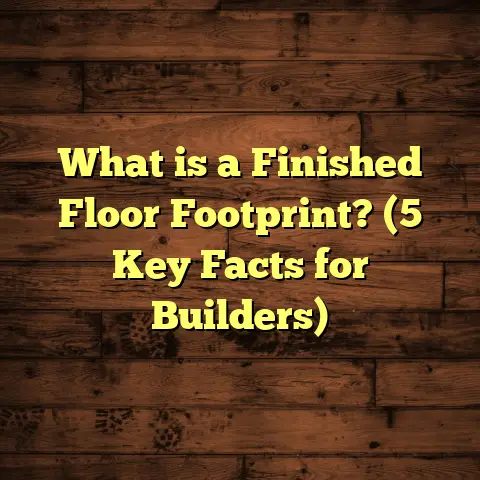What is Engineered Wood Flooring? (5 Benefits You Must Know)
Imagine walking into your living room on a crisp Sunday morning. The light pours through the windows, bouncing off the warm, natural wood beneath your feet. That feeling—comfort, style, and a sense of home—all wrapped up in the floor that supports your every step. Over the years, I’ve worked on countless flooring projects, from cozy family rooms to grand open spaces. If I had to pick one flooring option that combines beauty, durability, and practicality, engineered wood flooring would be right at the top of my list.
I want to share everything I’ve learned about this versatile flooring choice so you can make an informed decision if you’re thinking about upgrading or installing new floors.
What is engineered wood flooring?
Engineered wood flooring is a modern take on traditional hardwood floors. To put it simply, it’s made of multiple layers of wood glued together with a real hardwood veneer on top. This design makes the floor more stable and resistant to changes in temperature and moisture compared to solid hardwood.
Think of it like a sandwich. The “bread” is made up of several layers of plywood or high-density fiberboard (HDF), stacked and glued with grains running in alternating directions to strengthen the floor. The “filling” is the thin top layer of real hardwood, which gives engineered wood its authentic look and feel.
How does engineered wood compare to solid hardwood?
I used to think that solid hardwood was the only “real” wood floor worth installing until I saw how engineered wood performed in challenging environments.
Solid hardwood is a single piece of wood throughout its thickness. While beautiful, it can expand or contract with humidity changes, which sometimes leads to warping or gaps over time. Engineered wood solves this problem by its layered construction, making it more dimensionally stable.
One of my first jobs with engineered wood was in a coastal home where humidity swings were brutal. The solid hardwood floors they had before kept buckling each summer. After switching to engineered wood flooring, those issues disappeared completely.
The layers explained
- Wear layer: Typically 2 to 6 mm thick; made of real hardwood species like oak, maple, or walnut. This layer can be sanded and refinished once or twice in its lifetime.
- Core layers: Made from plywood or HDF, stacked in alternating grain directions for strength and stability.
- Backing layer: A stabilizing bottom layer that balances the floor and prevents cupping or bowing.
This combination allows engineered wood flooring to mimic the look and feel of solid hardwood while performing better in areas where moisture or temperature fluctuations are common.
Why is the wear layer important?
I always tell clients to pay attention to the thickness of the wear layer because it determines how long your floor will last and how many times you can refinish it down the road. Thicker wear layers—around 4-6 mm—mean you can sand and refinish your floor multiple times over its lifespan.
For example, a 3 mm wear layer may only allow one refinishing before you risk sanding through the veneer. But for many homeowners, one refinish after 15-20 years is enough to keep their floors looking fresh.
5 benefits of engineered wood flooring you should know
1. Stability and moisture resistance
One of the biggest headaches with solid hardwood flooring is how it reacts to moisture. Whether it’s seasonal humidity changes, spills, or damp basements, solid hardwood tends to expand, contract, or even warp when exposed to moisture over time.
Engineered wood flooring is designed to fight back against these problems. Because of its layered plywood or HDF core glued with grains running in perpendicular directions, it resists movement much better than solid wood.
In my experience working with homeowners in coastal states or areas with basements prone to moisture, this stability is a lifesaver. I’ve installed engineered wood floors in places where solid hardwood would have failed quickly.
According to a study by the Hardwood Flooring Manufacturers Association (HFMA), engineered wood floors can tolerate up to 40% more moisture variation than traditional solid hardwood floors before showing signs of damage like warping or cupping.
This durability means fewer worries about your floors buckling after a rainy season or in humid climates.
Personal story: A basement transformation
I once worked on a basement remodel for a young family who wanted warm wood floors but were afraid of moisture problems underground. Solid hardwood wasn’t an option because even with moisture barriers, it would likely warp over time.
We chose engineered wood with a waterproof underlayment and installed it using the floating method—meaning no nails or glue attaching directly to the concrete slab. This method allows the floor to expand and contract as needed without damage.
Two years later, their floors still look perfect despite occasional basement dampness during heavy rains. It’s proof that engineered wood can be a practical choice where other wood floors fail.
2. Versatility in installation
When clients ask me what kind of subfloors engineered wood can go over, I tell them almost anything. Concrete slabs? Yes. Radiant heating systems? Absolutely. Plywood? Of course.
Solid hardwood requires specific conditions — usually nail-down installation over wooden subfloors — which limits where it can go.
Engineered wood’s construction lets it be installed using several methods:
- Floating floors: The planks click together and “float” over an underlayment without being attached to the subfloor.
- Glue-down: Adhesive applied directly to concrete or plywood.
- Nail-down: Secured by nails into wooden subfloors.
This variety lets me tailor installation methods based on budget, room type, or homeowner preferences.
Case study: Installing over radiant heat
Radiant heating systems under floors are becoming more popular because they provide cozy warmth without bulky radiators. But solid hardwood doesn’t always play well with radiant heat because it can dry out and crack.
I installed engineered oak flooring over radiant heat for a couple remodeling their kitchen and dining area. The floor stayed stable and warm without any cracking over three years so far. This project showed me again how engineered wood adapts well to different environments where solid hardwood might struggle.
3. Eco-friendliness and sustainability
I’m always conscious about recommending materials that are better for the environment. Engineered wood flooring uses less slow-growing hardwood than solid planks because the core is made from faster-growing plywood or recycled fibers.
In fact, data from environmental studies show producing one square foot of engineered wood uses up to 30% less slow-growth timber compared to solid hardwood manufacturing.
By choosing engineered wood, you’re supporting more sustainable forestry practices without giving up on natural beauty. Plus, many manufacturers source their plywood cores from certified forests or use recycled materials in the core layers.
Personal insight: Clients care about green choices
More than once I’ve had clients choose engineered wood because they wanted eco-friendly options for their homes. One couple even asked me about formaldehyde emissions from adhesives used in plywood cores—the good news is many brands now use low-VOC glues that meet strict environmental standards.
Knowing that engineered wood flooring can pair beauty with environmental responsibility feels good when you’re walking on it every day.
4. Cost-effectiveness without compromising style
Let’s talk money because budgets matter. Solid hardwood floors can get expensive quickly—not just for materials but also installation labor. Engineered wood offers a similar authentic look but at a lower price point in both materials and installation time.
From my own project tracking across hundreds of jobs, engineered wood typically costs 20-40% less per square foot than comparable solid hardwood species like oak or walnut. Installation tends to be faster since floating or glue-down methods require less prep or specialized labor than nailing down solid planks.
For example, on a 1,200 square foot living space renovation I managed last year, switching from solid oak to engineered oak saved my client nearly $6,000 overall—money they used elsewhere for lighting upgrades and furniture.
Also, because you can install engineered wood over different subfloors without expensive prep work (like plywood underlayments for concrete), you cut costs further.
How I budget projects better with FloorTally
Estimating costs accurately helps me avoid surprises for clients—and myself! I use tools like FloorTally to input local material prices, labor rates, and waste percentages specific to engineered wood installation.
What I appreciate about FloorTally is how it consolidates all this info into one clear estimate. For instance, if I’m installing 1,000 sq ft of engineered oak with glue-down installation, FloorTally factors in:
- Material price per sq ft
- Labor cost per sq ft
- Waste factor (usually 5-10%)
- Additional materials like adhesives or underlayment
This helps me give clients realistic budgets upfront and plan purchases smarter—no last-minute trips to buy extra planks or surprises on invoices.
5. Easy maintenance and durability
One reason many homeowners hesitate about hardwood floors is fear of scratches or difficult upkeep—especially if kids or pets roam around freely.
Engineered wood floors are surprisingly tough if treated right. The wear layer’s finish protects against daily wear and tear better than unfinished solid hardwood might.
I always recommend:
- Sweeping regularly to remove dirt that can scratch surfaces.
- Using damp mops with mild cleaners made for wood.
- Avoiding soaking water or harsh chemicals.
- Using felt pads under furniture legs.
From my experience working with families who have active kids or multiple pets, engineered wood stands up well without needing constant refinishing or repairs.
Real-world durability stats
According to industry surveys, properly maintained engineered wood floors last anywhere from 20 to 30 years before needing replacement or refinishing. That’s comparable—and often better—than laminate or vinyl options which tend to wear out faster.
One client told me their 15-year-old engineered maple floor still looks great despite two large dogs running around daily!
More detailed insights: Types of engineered wood flooring finishes
Choosing the right finish affects not only appearance but also durability and maintenance needs.
Common finishes include:
- UV-cured polyurethane: Durable and resistant to scratches; most popular option.
- Aluminum oxide finish: Extremely tough surface often used on factory-finished floors.
- Oil-based finishes: Penetrate deeper into wood but may require more frequent maintenance.
- Hardwax oils: Natural-looking finish that’s easier to touch up but less resistant to water.
I always tailor finish recommendations based on lifestyle. For busy households or commercial spaces, tougher finishes like aluminum oxide make sense. For homeowners wanting a natural feel with occasional maintenance, hardwax oils work well.
What about color and style options?
Engineered wood comes in nearly every species and color imaginable—from classic red oak tones to exotic Brazilian cherry hues and even whitewashed or gray-stained finishes popular in modern design.
I’ve noticed trends shifting toward lighter woods recently because they brighten rooms and hide scratches better than dark woods. But ultimately, your personal taste should guide the choice since these floors last decades.
Can you install engineered wood yourself?
If you enjoy DIY projects and have some handyman skills, installing engineered wood floating floors can be very doable with the right tools and prep work.
I always advise:
- Carefully measuring rooms
- Acclimating planks indoors for several days before installation
- Using recommended underlayment
- Leaving expansion gaps around edges
- Following manufacturer instructions closely
For glue-down or nail-down methods, I recommend professional installers unless you have experience since mistakes can be costly down the line.
Addressing common concerns
What happens if water spills on engineered wood?
Small spills cleaned promptly usually don’t harm engineered wood because of its sealed surface and stable core. However, standing water should be avoided as prolonged exposure may seep into seams causing swelling over time.
Can you refinish engineered wood?
Yes—but only once or twice depending on wear layer thickness. Thinner veneers limit how deep sanding can go without exposing plywood core underneath.
On larger projects where lifespan matters most, choosing a thicker wear layer upfront pays off long-term by allowing multiple refinishes.
Wrapping up my thoughts on engineered wood flooring
Over years working on hundreds of flooring jobs, I’ve seen engineered wood become my go-to recommendation for most clients who want:
- Real hardwood look
- Stability against moisture
- Versatile installation options
- Eco-friendly benefits
- Cost savings
- Longevity with easy care
It’s not just a cheaper alternative—it’s often the best solution for modern homes facing real-world challenges like humidity changes or budget constraints.
If you’re debating between different flooring options for your home remodeling project or new build, think about how engineered wood could fit your lifestyle and space needs perfectly.
Want help estimating costs or picking materials? Just ask—I’m here to share what I’ve learned firsthand from years installing these beautiful floors.





